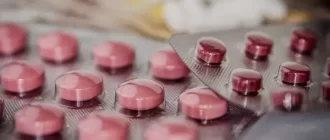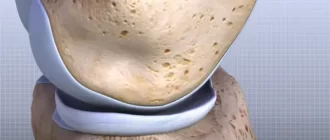This article will discuss the causes, symptoms, diagnosis, treatment, prognosis, and prevention of pain inside the knee after TKR.
Causes:
- Poor alignment of the prosthesis
- Loosening of the prosthesis
- Infection
- Wear of the components
- Nerve injury
Symptoms:
- Pain in the knee
- Swelling in the knee
- Limited range of motion
- Instability of the knee
- Difficulty bearing weight
Diagnosis:
The doctor will perform a physical exam to check for swelling and range of motion. Imaging tests such as X-rays and MRI scans may be ordered to check for alignment and loosening of the prosthesis.
See also: Knee Injections to Replace Cartilage Tissue Cells
Treatment Methods:
Physical therapy to improve range of motion and strength
A major procedure called a total knee replacement (TKR) is used to treat knee pain and regain function. Physical therapy (PT) is required after surgery to increase strength and range of motion, as well as to lessen pain.
You should concentrate on getting out of bed and moving around during the first few days following surgery. To assist you with this, you most likely have a continuous passive motion (CPM) machine. Your knee is flexed and extended for you by the CPM machine.
You will start performing PT exercises after a few days. The strength and range of motion will both be enhanced by these workouts. You’ll probably combine several exercises, such as:
- Passive range of motion: This is when someone else moves your leg for you.
- Active range of motion: This is when you move your leg yourself.
- Strengthening exercises: These exercises will help improve the strength of the muscles around your knee.
- Balance exercises: These exercises will help improve your balance and coordination.
For 4-6 weeks, you’ll probably engage in PT 3-5 times a week. For the following 4-6 weeks, you can perform physical therapy 1-2 times each week.
After a few weeks of PT, you should start to see improvements in your range of motion and strength. Your discomfort will be lessened by these adjustments.
Medications to reduce pain and inflammation
After a total knee replacement, a number of drugs can help minimize pain and swelling. Both prescription drugs like celecoxib and over-the-counter (OTC) remedies like ibuprofen and aspirin fall under this category.
Non-steroidal anti-inflammatory drugs (NSAIDs), such as ibuprofen, can help lessen pain and inflammation. It is sold over-the-counter in both generic and brand-name varieties, such as Advil and Motrin.
Another NSAID that can help lessen pain and inflammation is aspirin. Similar to ibuprofen, it is available over-the-counter in both generic and brand-name versions under the names Bayer and Bufferin.
An NSAID available only by prescription, celecoxib is used to alleviate pain and inflammation. Both generic and brand-name versions, like Celebrex, are offered.
Consult your doctor about the best treatment for you if you are still in pain and have inflammation after your TKR.
Surgery to realign or replace the prosthesis
You could be a candidate for surgery to realign or replace the prosthesis if you have knee discomfort following a total knee replacement (TKR). Usually, this operation is carried out to lessen discomfort and increase range of motion.
The previous prosthesis will be removed during surgery through an incision made above the knee. Then a new prosthesis will be inserted when the bones have been realigned. In some circumstances, the surgeon may also need to replace the patella (kneecap).
You’ll probably need to support yourself after the operation with a cane or walker. Your rehabilitation will also depend heavily on physical therapy. After this operation, the majority of patients report significantly less discomfort and an increase in range of motion.
Read also: Knee Flexion Pain
Prognosis:
The prognosis for pain inside the knee after knee replacement depends on the cause and the severity of the condition. In some cases, the pain may resolve with physical therapy and medications. In other cases, surgery may be needed to realign or replace the prosthesis.
Prevention:
The best way to prevent pain inside the knee after TKR is to ensure that the prosthesis is properly aligned and secure. Additionally, it is important to follow the doctor’s instructions for physical therapy and medications.
About the Author
Reyus Mammadli is the author of this health blog since 2008. With a background in medical and biotechnical devices, he has over 15 years of experience working with medical literature and expert guidelines from WHO, CDC, Mayo Clinic, and others. His goal is to present clear, accurate health information for everyday readers — not as a substitute for medical advice.







